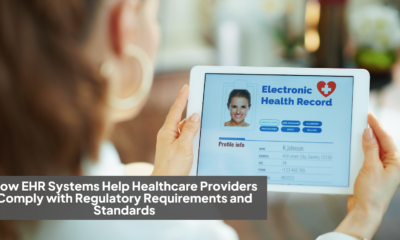Health
Streamlining Healthcare Data Management: A UX Approach
Healthcare The management of healthcare data presents major challenges for institutions

Introduction
The management of healthcare data presents major challenges for institutions globally in today’s digitally-driven world. The demands of healthcare administrators, providers, and patients—above all—are not always met by traditional approaches to data management because of the increasing volume and complexity of this type of data. In this blog, we examine how a user experience (UX) approach can transform healthcare data management by providing answers to the sector’s most pressing problems.
The Problem: Challenges of Healthcare Data Management
Healthcare data management presents a myriad of challenges
Interoperability issues
Healthcare data often comes from various sources, like hospitals, clinics, and labs, but these systems don’t always communicate well with each other.
Data security concerns
With sensitive patient information, keeping data safe from hackers and breaches is a top priority.
Inefficient workflows
The way data is managed can be clunky and slow, wasting time for healthcare professionals.
Fragmented systems
Different parts of the healthcare system might use different software, making it hard to access all the necessary information in one place.
Disparate data sources
Healthcare data comes from many places, but putting it all together can be like solving a puzzle without all the pieces.
Outdated user interfaces
Some software used in healthcare has old-fashioned designs that are hard to navigate and understand.
Cumbersome data entry processes
Inputting data into systems can be tedious and error-prone, leading to mistakes and frustration for staff.
Hindering quality care
All these challenges combined can make it harder for healthcare professionals to do their jobs well and provide the best care for patients.
The Solution: A UX Approach to Streamlining
As previously mentioned, excellent user experience (UX) design and implementation involves creating digital systems and interfaces that are more user-friendly, effective, and fulfilling for users. In light of this, users should feel at ease, involved, and guided when interacting with your website regarding healthcare.
Ultimately, the objectives of a healthcare website differ from those of a social media platform; rather than aiming for constant user engagement, our goal is to facilitate users’ access to information, decision-making, and action. Most users of healthcare websites are both patients and providers who need to communicate with one another in a quick, easy, and efficient manner while always keeping the patient’s needs in mind. For this reason, giving the user experience top priority in healthcare is crucial.
Benefits of a UX-driven Approach
Improved Patient Care:
Well-designed healthcare data management systems provide timely access to comprehensive patient information, enabling clinicians to make informed decisions quickly and enhance treatment outcomes.
LET’S SEE HOW
Enhanced Staff Productivity:
Healthcare professionals can concentrate more on providing patient care and less on juggling complicated digital platforms when the system is simpler to use. Good user experience can expedite a number of provider processes via the intranet of their company, such as:
- Platforms for telemedicine
- Digital implements
- administrative duties
- Data interpretation and display
- Handling patients and assisting in lowering burnout
Increased Patient Engagement:
User Experience (UX) plays a crucial role in how patients interact with online healthcare systems, such as telemedicine services, electronic health records (EHRs), appointment scheduling platforms, and hospital websites. We can significantly increase patient engagement and satisfaction by making things simple to use and obtain.
In an ideal world, patients could:
- Locate healthcare providers’ information without difficulty.
- Access their medical records with ease
- Make or cancel appointments with ease.
- Obtain medical advice remotely
- Get notified when appointments or prescriptions are coming up.
Streamlined Operations:
Administrators frequently handle a heavy workload on a daily basis, which can become stressful. A well-designed user experience (UX) on a healthcare intranet can reduce backlogs and maintain operations.
Simplified intranet user experience can benefit administrators:
- Increase the efficiency of billing, reporting, and scheduling.
- Reducing data backlogs
- Reduce expenses
- Increase the effectiveness of operations
Case Studies & Examples
Exmon is a well-known name in healthcare data management, trusted for its long-standing commitment to helping healthcare providers handle complex data effectively. It focuses on maintaining high data quality, adhering to regulations, and ensuring continuous monitoring to support the healthcare sector.
Features:
Exmon provides a range of features designed specifically for healthcare data management:
- Data Governance: Exmon offers a strong framework for managing data, ensuring accuracy, integrity, and compliance with healthcare regulations.
- Continuous Monitoring: With real-time monitoring, Exmon swiftly identifies issues to prevent compliance violations and data breaches.
Benefits:
Exmon offers several benefits beyond its feature
- Regulatory Compliance: It helps healthcare organizations comply with strict regulations like HIPAA and GDPR, ensuring the protection of patient data.
- Enhanced Patient Care: By maintaining high data quality, Exmon ensures that healthcare professionals have reliable information, ultimately improving patient care.
Future of UX in Healthcare Data Management
As technology continues to evolve, the future of healthcare data management lies in the hands of UX designers and innovators. By leveraging emerging technologies such as artificial intelligence (AI), machine learning (ML), and augmented reality (AR), design agency can create even more personalized and immersive experiences for healthcare professionals and patients alike. The integration of wearable devices, remote monitoring solutions, and predictive analytics will further enhance the capabilities of healthcare data management systems, paving the way for a more connected and patient-centric future.
Conclusion
In conclusion, a UX-driven approach holds immense potential for streamlining healthcare data management and improving the quality of care delivery. By prioritizing the needs of users and designing intuitive, user-friendly solutions, healthcare organizations can overcome the challenges associated with managing vast amounts of data and empower both healthcare professionals and patients to make informed decisions and achieve better health outcomes. As the healthcare industry continues to embrace digital transformation, investing in UX design will be essential for driving innovation, enhancing efficiency, and ultimately, improving the health and well-being of individuals worldwide.
Table of Contents
-

 Business5 months ago
Business5 months agoSepatuindonesia.com | Best Online Store in Indonesia
-

 Technology3 weeks ago
Technology3 weeks agoTop High Paying Affiliate Programs
-

 Tech5 months ago
Tech5 months agoAutomating Your Window Treatments: The Advantages of Auto Blinds
-

 Tech5 months ago
Tech5 months agoUnleash Your Potential: How Mecha Headsets Improve Productivity and Focus
-

 Instagram2 years ago
Instagram2 years agoFree Instagram Follower Without Login
-

 Reviews11 months ago
Reviews11 months agoAndroid Laptop vs. Chromebook: Which one is better?
-

 Instagram2 years ago
Instagram2 years agoIGTOK – Get Instagram Followers, Likes & Comments
-

 Business8 months ago
Business8 months agoFollow These 5 Tips To Avail Personal Loans At Lower Interest Rates
























